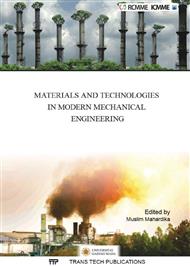[1]
R. Viswanathan. and J. Stringer, Failure Mechanisms of High Temperatur Components in Power Plants, Electric Power Research Institute, Palo Alto, CA 95070. (2009).
Google Scholar
[2]
Feng Zhili, Processes and Mechanisms of Welding Residual Stress and Distortion, Padstow, Cornwall, England, (2005).
Google Scholar
[3]
M. Mochizuki, and M. Toyoda,., Weld Distortion Control During Welding Prosess with Reverse-Side Heating, Journal of Engineering Material, (2007), Vol. 129.
DOI: 10.1115/1.2400275
Google Scholar
[4]
T.D. Huang, R. Dull, C. Conrardy, N. Porter, L. DeCan, N. Evans, A. Davis, L. Kvidahl and P. Keene, Transient Thermal Tensioning and Protoyype System Testing of Thin Steel Ship Panel Structures, The sociaty of Nafal Architeects and Marine Enggineer. pp.1-16.
DOI: 10.5957/jsp.2008.24.1.25
Google Scholar
[5]
M.N. Ilman, Kusmono, and P.T. Iswanto, Fatigue crack growth rate behaviour of friction-stir aluminium alloy AA2024-T3 welds under transient thermal tensioning, Journal of Materials and Design, Elsevier, (2013) pp.235-243.
DOI: 10.1016/j.matdes.2013.02.081
Google Scholar
[6]
C. Conrardy T.D. Huang, D. Harwig. P. Dong, L. Kvidahl, N. Evans, and A. Treaster, Practical Welding Tecnichues to Minimize Distortion in Lighweight Ship Strctures, J. Ship Produktion, The sociaty of Nafal Architeects and Marine Enggineer, volume 22, No. 4, (2006).
DOI: 10.5957/jsp.2006.22.4.239
Google Scholar
[7]
P. L. Harrison, dan R. A. Farrar, , Influence of Oxigen-rich Inclusions on the γ a Phase Transformation in High Strength Low Alloy (HSLA) Steel Weld Metals, Journal of Material Science, 16, (1981) pp.2218-2226.
DOI: 10.1007/bf00542384
Google Scholar
[8]
N. Subeki, Optimalisasi Penggunaan Heat Input pada Pengelasan Pipa Spiral untuk Meningkatkan kualitas Sambungan, Jurnal Teknik Industri Vol. 10 Nomor 2. Agustus 2009 Hal 141-147.
Google Scholar
[9]
E.S. Surian, N.M. Ramini De Risone, H.G. Svoboda, H.G. R Rep, and L.A. De Vedia, SMAW, FCAW, and SAW High-Strength Ferritic Deposits : The Challenge Is Tensile Properties, Welding Journal Vol. 89 (2010) p.54-S- 64-S.
Google Scholar
[10]
D. Gery, H. Long, and P. Maropoulos, Effects of Welding Speed, Energy Input and Heat Source Distribution on Temperature Variation in Butt Joint Welding, Journal of Materials Tecnology 167, (2005) pp.393-401.
DOI: 10.1016/j.jmatprotec.2005.06.018
Google Scholar
[11]
J. Song, J. Peters, A. Noor, and P. Michaleris, Sensitivity Analysis of The Thermomechanical Response of Welding Joints, Journal of Solids and Struktures 40, (2003) pp.4167-4180.
DOI: 10.1016/s0020-7683(03)00223-3
Google Scholar
[12]
J. Roesler, H. Harders, and M. Baeker, Mechanical Behaviour of Engineering Materials, Springer Berlin Heidelberg New York, (2007).
Google Scholar
[13]
Sirama dan M.N. Ilman, Pengaruh Preheat terhadap Laju Perambatan Retak Fatik Sambungan Las TIG pada Pengelasan Aluminium Paduan 6061-T6, Tesis, UGM, Yokyakarta, (2011).
DOI: 10.21776/ub.jrm.2022.013.01.17
Google Scholar


